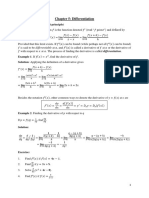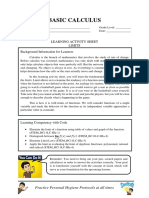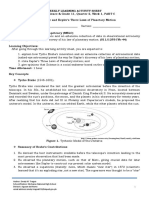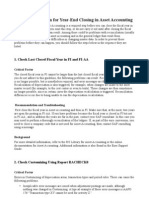Continuity: Definition: Continuity of A Function at A Number
Continuity: Definition: Continuity of A Function at A Number
Uploaded by
Derren Nierras GayloCopyright:
Available Formats
Continuity: Definition: Continuity of A Function at A Number
Continuity: Definition: Continuity of A Function at A Number
Uploaded by
Derren Nierras GayloOriginal Description:
Original Title
Copyright
Available Formats
Share this document
Did you find this document useful?
Is this content inappropriate?
Copyright:
Available Formats
Continuity: Definition: Continuity of A Function at A Number
Continuity: Definition: Continuity of A Function at A Number
Uploaded by
Derren Nierras GayloCopyright:
Available Formats
CONTINUITY
Definition : Continuity of a Function at a Number
A function f is said to be continuous at a number a if and only if the following three
conditions are satisfied:
(1) 𝑓(𝑎) exists
(2) lim 𝑓(𝑥) 𝑒𝑥𝑖𝑠𝑡𝑠
𝑥→𝑎
(3) lim 𝑓(𝑥) = 𝑓(𝑎)
𝑥→𝑎
If one or more of these conditions fails to hold a, the function f is said to be
discontinuous at a.
It should be apparent that the geometric notion of a break in the graph at a certain point is
synonymous with the concept of a function being discontinuous at a certain value of the independent
variable.
Removable discontinuity happens when the function f is discontinuous at a number a, but for
which lim 𝑓(𝑥) 𝑒𝑥𝑖𝑠𝑡𝑠. Then either lim 𝑓(𝑥) ≠ 𝑓(𝑎) or 𝑓(𝑎) does not exists. The function can be
𝑥→𝑎 𝑥→𝑎
redefined at a such that f(a) is equal to lim 𝑓(𝑥), then the new function becomes continuous at a. If
𝑥→𝑎
the discontinuity is not removable, it is called as essential discontinuity.
A jump discontinuity happens when the right-hand and the left-hand limits both exist, but are
not equal. Thus, lim 𝑓(𝑥) 𝑑𝑜𝑒𝑠 𝑛𝑜𝑡 𝑒𝑥𝑖𝑠𝑡𝑠. The size of the jump is the difference between the right-
𝑥→𝑎
hand and left-hand limits. On the other hand, an infinite discontinuity occurs when the one-sided
limits exist, and at least one of them is ±∞.
Examples:
𝑥 2 −1 2𝑥 + 3, 𝑖𝑓 𝑥 ≠ 1
1. 𝑓(𝑥) = 4. 𝑓(𝑥) = {
𝑥+1 2, 𝑖𝑓 𝑥 = 1
−1, 𝑖𝑓 𝑥 < 0 1
2. 𝑔(𝑥) = { 5. 𝑓(𝑥) =
1, 𝑖𝑓 𝑥 > 0 𝑥−2
1 3 + 𝑥, 𝑖𝑓 𝑥 ≤ 1
3. ℎ(𝑥) = 6. ℎ(𝑥) = {
𝑥2 3 − 𝑥, 𝑖𝑓 1 < 𝑥
Exercises:
A. Determine the numbers at which the function is continuous:
1. 𝑓(𝑥) = 𝑥 2 (𝑥 + 3)2
𝑥
2. 𝑔(𝑥) = 𝑥−3
𝑥 3 +7
3. 𝐹(𝑥) = 𝑥 2 −4
3𝑥 − 1, 𝑖𝑓 𝑥 < 2
4. 𝑓(𝑥) = {
4 − 𝑥 2 , 𝑖𝑓 2 ≤ 𝑥
1
, 𝑖𝑓 𝑥 ≤ 1
5. 𝑓(𝑥) = {𝑥+1
1
, 𝑖𝑓 1 < 𝑥
3−𝑥
3
𝑥 + √𝑥 , 𝑖𝑓 𝑥 < 0
6. ℎ(𝑥) = {
𝑥 − √𝑥, 𝑖𝑓 0 ≤ 𝑥
You might also like
- Occult Cosmology by Bruce LyonDocument214 pagesOccult Cosmology by Bruce LyonJohn SkybirdwalkingbearNo ratings yet
- Card Sort Limits and ContinuityDocument8 pagesCard Sort Limits and ContinuityAN NGUYENNo ratings yet
- Hsslive-XII_CH5 CONTINUITY & DIFFERENTIABILITYDocument13 pagesHsslive-XII_CH5 CONTINUITY & DIFFERENTIABILITYryfyfyfhonojoNo ratings yet
- Handouts - Week 4 & 5Document9 pagesHandouts - Week 4 & 5ryk cesarNo ratings yet
- M - Difrn-Continuity ImpqDocument1 pageM - Difrn-Continuity ImpqAdarsh GopakumarNo ratings yet
- Limits and ContinuityDocument9 pagesLimits and ContinuityShivani KumariNo ratings yet
- Chapter 5 Continuity and Differentiability - 57988765 Fe40 4100 Acf7 3d5b6bee942dDocument69 pagesChapter 5 Continuity and Differentiability - 57988765 Fe40 4100 Acf7 3d5b6bee942dJasmine KaurNo ratings yet
- 03 - HW Function Limits A ProblemsDocument4 pages03 - HW Function Limits A ProblemsMaxNo ratings yet
- Lesson5A Continuity of A Function v1Document13 pagesLesson5A Continuity of A Function v1Charmene CambaNo ratings yet
- L1t - Derivative of Polynomial FunctionsDocument4 pagesL1t - Derivative of Polynomial FunctionsimemmamengNo ratings yet
- 2.3 Worksheet Do All Work On Your Own Paper!Document5 pages2.3 Worksheet Do All Work On Your Own Paper!princess nesrin milicanNo ratings yet
- Limits at InfinityDocument2 pagesLimits at InfinityMark Jason EsguerraNo ratings yet
- Limits at Infinity-EsguerraDocument2 pagesLimits at Infinity-EsguerraMark Jason EsguerraNo ratings yet
- Derivative 1Document14 pagesDerivative 1yousifshli0No ratings yet
- Continuity and Differentiability Xii (1) (2)Document2 pagesContinuity and Differentiability Xii (1) (2)mk1800781No ratings yet
- Calculus 1: LimitsDocument6 pagesCalculus 1: LimitsAlie Lee GeolagaNo ratings yet
- Limit Unit 1Document19 pagesLimit Unit 1frimponglordoscar1No ratings yet
- CECC481 - Differential CalculusDocument2 pagesCECC481 - Differential CalculusjesselmktNo ratings yet
- Card Sort Limits and ContinuityDocument8 pagesCard Sort Limits and ContinuityAN NGUYENNo ratings yet
- Week 6Document2 pagesWeek 6詹茗宗No ratings yet
- 03 - HW Function Limits A ProblemsDocument4 pages03 - HW Function Limits A ProblemsasdfNo ratings yet
- 03 - HW Function Limits Problems - SupplDocument3 pages03 - HW Function Limits Problems - SupplMaxNo ratings yet
- 13.limits and DerivativesDocument23 pages13.limits and DerivativeshiNo ratings yet
- 3 Continuity of FunctionsDocument25 pages3 Continuity of FunctionssuzuhaulsNo ratings yet
- Lesson 4 Continuity and Derivative PDFDocument31 pagesLesson 4 Continuity and Derivative PDFVelante IrafrankNo ratings yet
- 04 - HW Derivatives ProblemsDocument3 pages04 - HW Derivatives ProblemsMaxNo ratings yet
- Continuity FullDocument36 pagesContinuity FullBalashiv KumaranNo ratings yet
- Relations and Functions a-6Document6 pagesRelations and Functions a-6Bhakti GargNo ratings yet
- Edited CalculusDocument3 pagesEdited CalculusKenneth TimbrezaNo ratings yet
- Presentador: M. en C. José Manuel Rosales Guzmán 13/07/2021Document1 pagePresentador: M. en C. José Manuel Rosales Guzmán 13/07/2021José Manuel Rosales GuzmánNo ratings yet
- BASCAL (PPT6)Document25 pagesBASCAL (PPT6)lozarilla042108No ratings yet
- Continuity of A Function at A Point: Lec-7 (Applied Calculus) B.Sc. Engineering 1 SemesterDocument8 pagesContinuity of A Function at A Point: Lec-7 (Applied Calculus) B.Sc. Engineering 1 SemesterALI ZUBAIRNo ratings yet
- 4 the Derivative as the Slope of the Tangent Line (1) (1)Document41 pages4 the Derivative as the Slope of the Tangent Line (1) (1)Joyce Karylle GarciaNo ratings yet
- MAT1100 Integral Calculus I - 2020Document6 pagesMAT1100 Integral Calculus I - 2020Potrine MuzumbaNo ratings yet
- Business Maths Chapter 5Document9 pagesBusiness Maths Chapter 5鄭仲抗No ratings yet
- Assignment1Document3 pagesAssignment1saberhasan8989No ratings yet
- BASICCALDocument7 pagesBASICCALAngel OrodioNo ratings yet
- Chap 6 LIMIT AND CONTINUITY (S - Week 8)Document16 pagesChap 6 LIMIT AND CONTINUITY (S - Week 8)ADELLINNE NATASYA BINTI ROSDI / UPMNo ratings yet
- Lesson 4Document19 pagesLesson 4Yelly HazeNo ratings yet
- Differential CalculusDocument17 pagesDifferential Calculuskhenley heartNo ratings yet
- Lecture 08Document23 pagesLecture 08habibullah abedNo ratings yet
- Simple ClasDocument14 pagesSimple Clas1201M - Ayson, MichaelNo ratings yet
- 07 - HW Extrema Inflection ProblemsDocument5 pages07 - HW Extrema Inflection Problemskv.vladislav.vNo ratings yet
- Chapter (2) :aDocument26 pagesChapter (2) :asalmabinescobarNo ratings yet
- Module 3 Calculus (Derivatives of Functions)Document16 pagesModule 3 Calculus (Derivatives of Functions)Michael AliagaNo ratings yet
- Cont. & Diff.Document7 pagesCont. & Diff.HimaniNo ratings yet
- Lecture 4 Limits at Infinity and Infinite LimitsDocument5 pagesLecture 4 Limits at Infinity and Infinite LimitsJoy Rianne HoriqueNo ratings yet
- Calculus+1+ +Limits+ +Worksheet+13+ +ContinuityDocument13 pagesCalculus+1+ +Limits+ +Worksheet+13+ +Continuitykamilahford05No ratings yet
- calculus IDocument55 pagescalculus Iahmedessam9.aeNo ratings yet
- Continuity CN2Document2 pagesContinuity CN2Rayeed AminNo ratings yet
- Basic Calculus: Learning Activity Sheet Limits Background Information For LearnersDocument15 pagesBasic Calculus: Learning Activity Sheet Limits Background Information For LearnersDaniella Kriztanna SebastianNo ratings yet
- Lecture#11 ContinuityDocument25 pagesLecture#11 Continuityaoun.m.8255No ratings yet
- 3homogenous ThirdLecture 2ndchemistryDocument3 pages3homogenous ThirdLecture 2ndchemistrySayd KamalNo ratings yet
- DerivadasDocument7 pagesDerivadasFausto Alejandro Mogrovejo TeneNo ratings yet
- Continuity: Standard Results For Continuity of FunctionsDocument7 pagesContinuity: Standard Results For Continuity of FunctionsNickifah AlleyneNo ratings yet
- Continuity and Differentiability L2Document44 pagesContinuity and Differentiability L2Vishesh JainNo ratings yet
- Fourier Series and Some ApplicationsDocument18 pagesFourier Series and Some ApplicationsMarwan ElsayedNo ratings yet
- Curve Sketching: Example 1Document22 pagesCurve Sketching: Example 1Hin Wa LeungNo ratings yet
- GenMath_Q1_LAS4_One-to-One-and-Inverse-FunctionsDocument12 pagesGenMath_Q1_LAS4_One-to-One-and-Inverse-FunctionsyeonjunasawaniNo ratings yet
- Handout 1.2.3 (Calculus 2)Document3 pagesHandout 1.2.3 (Calculus 2)dicocessNo ratings yet
- A-level Maths Revision: Cheeky Revision ShortcutsFrom EverandA-level Maths Revision: Cheeky Revision ShortcutsRating: 3.5 out of 5 stars3.5/5 (8)
- Employment, Employability and Competencies of The Bachelor of Secondary Education GraduatesDocument10 pagesEmployment, Employability and Competencies of The Bachelor of Secondary Education GraduatesDerren Nierras GayloNo ratings yet
- Linear Functions TestDocument2 pagesLinear Functions TestDerren Nierras GayloNo ratings yet
- Notes On SET THEORYDocument3 pagesNotes On SET THEORYDerren Nierras GayloNo ratings yet
- Metacognitive Strategies: Their Efffects To Academic Performance and EngagementDocument21 pagesMetacognitive Strategies: Their Efffects To Academic Performance and EngagementDerren Nierras Gaylo100% (1)
- Interactive Online and Offline Games TheDocument8 pagesInteractive Online and Offline Games TheDerren Nierras GayloNo ratings yet
- AlgebDocument2 pagesAlgebDerren Nierras GayloNo ratings yet
- Complex FractionDocument1 pageComplex FractionDerren Nierras GayloNo ratings yet
- Logic and Set Theory Activity 2Document1 pageLogic and Set Theory Activity 2Derren Nierras GayloNo ratings yet
- Algebraic Expression AdditionDocument2 pagesAlgebraic Expression AdditionDerren Nierras GayloNo ratings yet
- Dif EqDocument1 pageDif EqDerren Nierras Gaylo0% (1)
- Test On SetsDocument1 pageTest On SetsDerren Nierras GayloNo ratings yet
- StocksDocument1 pageStocksDerren Nierras GayloNo ratings yet
- Differentiation ExercisesDocument1 pageDifferentiation ExercisesDerren Nierras GayloNo ratings yet
- Inverse FunctionsDocument1 pageInverse FunctionsDerren Nierras Gaylo100% (1)
- Interest ProblemsDocument1 pageInterest ProblemsDerren Nierras GayloNo ratings yet
- Composite FunctionDocument2 pagesComposite FunctionDerren Nierras GayloNo ratings yet
- ParabolaDocument1 pageParabolaDerren Nierras GayloNo ratings yet
- If I Forgot Thee, Oh EarthDocument22 pagesIf I Forgot Thee, Oh EarthEricaNo ratings yet
- Mock Bar Examination Questions in Legal Ethics and Legal and Judicial FormsDocument21 pagesMock Bar Examination Questions in Legal Ethics and Legal and Judicial FormsrolandbcaspeNo ratings yet
- Sanford Invisible Partners Male FemaleDocument146 pagesSanford Invisible Partners Male FemaleJohn Suarez100% (5)
- GRADES 1 To 12 Daily Lesson Log 7 Mapeh/P.E SEPTEMBER (8 SESSIONS/45 Min - Per Session 3 Quarter Session1 Session2 Session3 Session4Document3 pagesGRADES 1 To 12 Daily Lesson Log 7 Mapeh/P.E SEPTEMBER (8 SESSIONS/45 Min - Per Session 3 Quarter Session1 Session2 Session3 Session4Arbil Avodroc NoliugaNo ratings yet
- Concept of Health and IllnessDocument28 pagesConcept of Health and IllnessCeline Eliz Ang86% (7)
- Chapter One 1.0 Background of The StudyDocument35 pagesChapter One 1.0 Background of The StudyAjegbomogun SundayNo ratings yet
- George C. Miles - The Coinage of The Visigoths of Spain, Leovigild To Achila IIDocument590 pagesGeorge C. Miles - The Coinage of The Visigoths of Spain, Leovigild To Achila IIstefanNo ratings yet
- Past and PresentDocument3 pagesPast and PresentAgustin Santiago AriasNo ratings yet
- Nature of Action ResearchDocument25 pagesNature of Action ResearchRyan SuarezNo ratings yet
- Butler 2007Document13 pagesButler 2007javiera.aracenaNo ratings yet
- CH 7 PresentationDocument32 pagesCH 7 PresentationJes KnehansNo ratings yet
- NFL HR Marketing SyllabusDocument4 pagesNFL HR Marketing SyllabusswathitamilNo ratings yet
- Esp10 q1 Week3-4Document19 pagesEsp10 q1 Week3-4Anna Rose TabafundaNo ratings yet
- Swing Trading and Underlying Principles of Technical Analysis by Linda RaschkeDocument41 pagesSwing Trading and Underlying Principles of Technical Analysis by Linda RaschkeDuck Foo100% (2)
- Author: Emely M. Tragua School/Station: Kitcharao National High School Division: Agusan Del Norte Email Address:emely - Tragua001@deped - Gov.phDocument6 pagesAuthor: Emely M. Tragua School/Station: Kitcharao National High School Division: Agusan Del Norte Email Address:emely - Tragua001@deped - Gov.phShekaina Faith Cuizon Lozada100% (2)
- Year End Closing in Asset AccountingDocument8 pagesYear End Closing in Asset Accountingudayredekar100% (1)
- Radiotherapy in Prostate Cancer Innovative Techniques and Current ControversiesDocument288 pagesRadiotherapy in Prostate Cancer Innovative Techniques and Current ControversiesStir100% (2)
- DruzeDocument9 pagesDruzeapi-582823140No ratings yet
- Engineering Software & Applications (EE038-3.5-2) : InstructionsDocument7 pagesEngineering Software & Applications (EE038-3.5-2) : InstructionsEmad KhanNo ratings yet
- Adam EveDocument134 pagesAdam EveJulian Ungar-SargonNo ratings yet
- Soal Bahasa Inggris Unit 1 Kelas VIIDocument7 pagesSoal Bahasa Inggris Unit 1 Kelas VIIAan Ramadhansyah0% (1)
- Authors BirthdaysDocument9 pagesAuthors BirthdaysKalbu Trenerė VirginijaNo ratings yet
- 5 Ways To Fix Slow 802.11n Speed - SmallNetBuilderDocument5 pages5 Ways To Fix Slow 802.11n Speed - SmallNetBuilderShree Vishnu ShastriNo ratings yet
- The SAGES Manual of Quality, Outcomes and Patient SafetyDocument626 pagesThe SAGES Manual of Quality, Outcomes and Patient SafetySolha100% (1)
- Urine Specimen Collection - How A Multidisciplinary Team Improved Patient Outcomes Using Best Practices - ProQuestDocument9 pagesUrine Specimen Collection - How A Multidisciplinary Team Improved Patient Outcomes Using Best Practices - ProQuestHelmy HanafiNo ratings yet
- Handcuffing SuspectsDocument25 pagesHandcuffing SuspectsRanier Factor Aguilar100% (1)
- Compass 2012 PDFDocument624 pagesCompass 2012 PDFGhita Petrus100% (1)
- Depression စစစစစစစစစစစ စ (စစစစစစစ စစစစစစစ)Document7 pagesDepression စစစစစစစစစစစ စ (စစစစစစစ စစစစစစစ)Nicole NoonaNo ratings yet
- Selection and Use of Teaching StrategiesDocument22 pagesSelection and Use of Teaching Strategiesali orenciana90% (21)










































































































